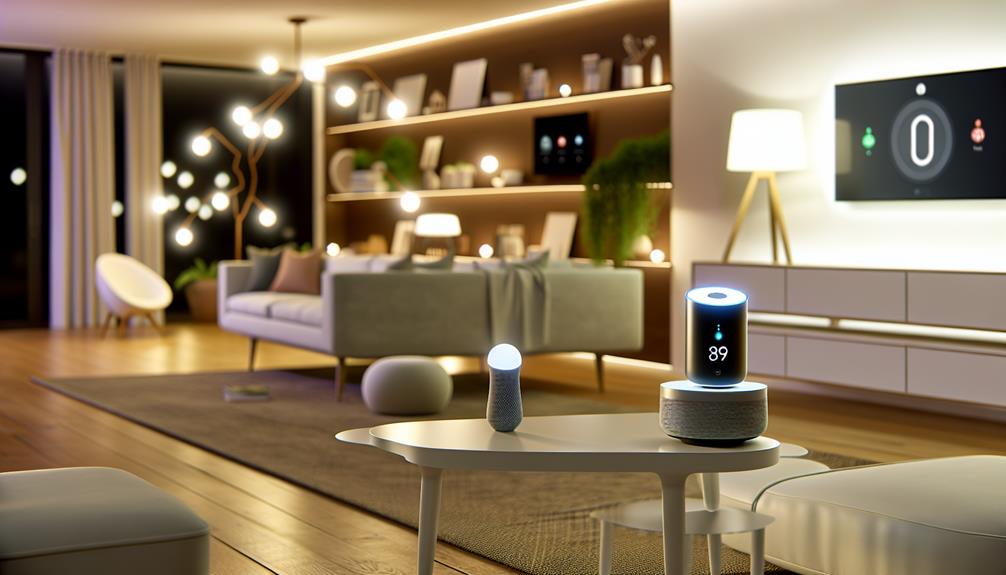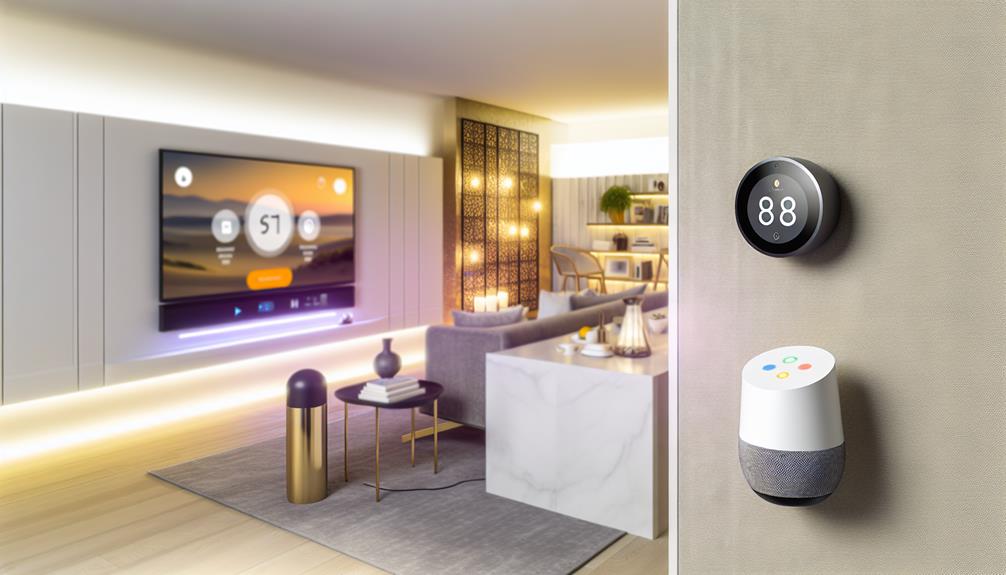Can AI Automation Really Improve Home Security?
The advent of AI automation has sparked significant interest in its potential to enhance home security systems. By leveraging advanced algorithms and machine learning, these technologies promise not only to detect threats more efficiently but also to predict them before they occur. However, as we explore the practical implications of such innovations, it becomes essential to contemplate both their effectiveness and the ethical dimensions surrounding privacy. What challenges might arise as we integrate these sophisticated solutions into our daily lives, and do the benefits truly outweigh the potential risks?
Key takeaways
- AI automation enhances home security through predictive analytics, identifying potential threats before they occur and enabling proactive measures.
- Advanced surveillance systems utilize facial recognition and behavioral analysis, improving monitoring accuracy and response to unusual activities.
- Real-time threat detection and automated alerts keep homeowners informed about potential breaches, allowing for immediate action.
- Smart sensors and intelligent alarm systems increase responsiveness, ensuring quicker reaction times to security incidents.
- Integration with smart home systems allows seamless control and monitoring, enhancing overall safety and convenience for homeowners.
Understanding AI in Home Security
Artificial intelligence (AI) has emerged as a transformative force in home security systems, enhancing their capabilities through advanced algorithms and data analytics. By leveraging machine learning, these systems can analyze vast amounts of data to identify patterns and predict potential security threats. This predictive capability allows homeowners to take proactive measures, greatly reducing the likelihood of incidents.
Incorporating biometric security features, such as facial recognition and fingerprint scanning, further strengthens home security. These technologies provide a higher level of authentication, ensuring that only authorized individuals can access a property. Unlike traditional security measures, which can be circumvented, biometric systems offer a unique layer of protection that adapts to the specific characteristics of each user.
Moreover, AI-driven home security systems are designed to learn from their environments. They can adjust their responses based on previous interactions, making them more efficient and effective over time. This continuous improvement fosters a sense of belonging for homeowners, as they can trust that their security measures are not only robust but also evolving to counter new threats.
To conclude, AI in home security represents a considerable advancement, integrating machine learning and biometric technology for enhanced safety and peace of mind.
Benefits of AI-Driven Devices
AI-driven devices greatly enhance home security through advanced surveillance capabilities that monitor surroundings with precision.
By employing real-time threat detection algorithms, these systems can identify potential risks and respond proactively.
Furthermore, automated alerts guarantee that homeowners are promptly informed of any suspicious activities, thereby improving overall safety and response times.
Enhanced Surveillance Capabilities
The integration of advanced technology into home security systems has revolutionized the way surveillance is conducted, offering unprecedented benefits through intelligent devices. AI-driven solutions enhance traditional surveillance capabilities by employing facial recognition, motion detection, and behavioral analysis to identify potential threats effectively. These features allow homeowners to monitor their properties with a level of precision previously unattainable.
However, the adoption of these technologies raises privacy concerns. To address this, robust data encryption and secure cloud storage are essential in protecting sensitive information. User customization options further empower homeowners to tailor surveillance settings according to their preferences.
The following table summarizes the enhanced surveillance capabilities provided by AI-driven devices:
| Feature | Benefits | Considerations |
|---|---|---|
| Facial Recognition | Identifies known individuals | Privacy concerns |
| Motion Detection | Alerts for unusual activity | False positives |
| Behavioral Analysis | Predicts potential threats | Data accuracy |
| Incident Playback | Review past events | Storage requirements |
| Remote Access | Monitor from anywhere | Security vulnerabilities |
Moreover, environmental monitoring capabilities contribute to a thorough approach to home security. As these technologies evolve, they offer homeowners a greater sense of safety and belonging within their communities.
Real-Time Threat Detection
In an era where security is paramount, real-time threat detection has emerged as a cornerstone of modern home security solutions. By leveraging advanced machine learning algorithms, AI-driven devices can continuously analyze behavioral patterns within a household, ensuring swift anomaly detection. This capability allows systems to identify unusual activities that might signify potential threats, enhancing overall safety.
Moreover, AI systems facilitate threat prioritization, enabling homeowners to focus on the most pressing concerns. With user customization features, individuals can tailor notifications and responses based on their unique security needs, fostering a sense of belonging and empowerment within their living spaces.
Data encryption plays a vital role in addressing privacy concerns, ensuring that sensitive information remains secure while systems monitor for threats. Coupled with established emergency protocols, these AI-driven solutions can streamline responses, providing peace of mind for homeowners.
Ultimately, the integration of real-time threat detection not only enhances home security but also fosters a more responsive environment, where families can feel safe and secure.
As technology continues to evolve, the benefits of these systems will only grow, making them essential in the pursuit of thorough home safety.
Automated Alerts and Responses
While traditional security systems often rely on manual monitoring and delayed responses, automated alerts and responses offered by modern home security solutions greatly enhance the efficiency and effectiveness of threat management. These systems are designed to provide real-time automated notifications to homeowners, ensuring that they are promptly informed of any potential security breaches.
Through sophisticated algorithms and machine learning, AI-driven devices can assess various data points, such as movement patterns or unusual activity, allowing for proactive measures before a situation escalates. For instance, if a sensor detects unauthorized entry, the system can instantly alert the homeowner and, in some cases, notify local law enforcement.
This immediacy not only mitigates risks but also fosters a sense of belonging and security within the community, as residents can collaborate more effectively to safeguard their surroundings.
Moreover, the integration of automated alerts helps alleviate the burden of constant vigilance, enabling homeowners to enjoy peace of mind. Overall, the shift from reactive to proactive security measures signifies a monumental advancement in home safety, making AI-driven solutions indispensable for modern living.
Smart Cameras and Surveillance
As security concerns continue to escalate, the integration of smart cameras into home surveillance systems has emerged as a vital advancement in personal safety. These devices, often equipped with facial recognition technology, enhance the ability to identify individuals entering or leaving a property.
However, the implementation of such features raises significant privacy concerns, necessitating a balance between security and individual rights. To mitigate these concerns, robust data encryption methods must be employed to protect sensitive information. User consent is essential, as homeowners should be informed about how their data is utilized.
Additionally, the ethical implications of surveillance technology demand careful consideration, particularly regarding its potential misuse. While smart cameras offer improved system reliability, they are not without challenges. Installation can be complex, requiring technical expertise to guarantee ideal functionality, which can be a barrier for some users.
Cost considerations also play a role, as high-quality systems may require significant investment. Regular software updates are vital for maintaining security and performance. Finally, user education is imperative to empower homeowners, enabling them to use these technologies effectively while understanding their rights and responsibilities in the digital age.
Intelligent Alarm Systems
Intelligent alarm systems represent a significant advancement in home security through the integration of smart sensors that enhance detection capabilities.
These systems provide real-time alerts to homeowners, ensuring timely responses to potential threats.
Additionally, remote monitoring features empower users to oversee their properties from anywhere, further bolstering security measures.
Smart Sensors Integration
The integration of smart sensors into alarm systems has revolutionized the landscape of home security, enhancing both responsiveness and reliability. Various sensor types, such as motion detectors, door/window sensors, and environmental monitors, provide extensive coverage, yet they come with installation challenges and ongoing maintenance requirements.
Properly configuring these systems is critical, as compatibility issues can arise when integrating multiple devices from different manufacturers. User customization options allow homeowners to tailor their security systems to specific needs, but this also introduces privacy concerns. Data security must be prioritized to protect sensitive information from unauthorized access.
Additionally, the cost implications of installing a fully integrated smart sensor system can be significant, especially when considering potential upgrade paths to keep pace with technological advancements. Performance metrics are essential for evaluating the effectiveness of these systems, enabling users to assess how well their alarms respond to threats.
Balancing these factors ultimately leads to a more secure environment, fostering a sense of belonging and peace of mind. As the technology continues to evolve, homeowners must remain informed to navigate the complexities and maximize the benefits of smart sensor integration in their security systems.
Real-Time Alerts
Smart sensor integration serves as a foundation for advancing home security through real-time alerts provided by intelligent alarm systems. These systems are designed to monitor various parameters, such as motion, sound, and environmental changes, enabling homeowners to receive immediate notifications regarding potential security breaches or anomalies.
By utilizing advanced algorithms, intelligent alarm systems can differentiate between routine activity and unusual behavior, thereby facilitating proactive measures to protect the home.
When a potential threat is detected, the system can instantly send alerts to homeowners via smartphone notifications or automated calls, allowing for timely incident response. This immediacy not only empowers residents to take swift action but also fosters a sense of community, as individuals can coordinate with neighbors or local authorities if necessary.
Additionally, real-time alerts contribute to the overall effectiveness of home security by minimizing response times to incidents, whether they involve unauthorized entry, fire hazards, or other emergencies.
Incorporating real-time alerts into home security systems epitomizes a modern approach to safeguarding one's residence, enhancing both safety and peace of mind for families who seek to protect their living environments.
Remote Monitoring Capabilities
A robust feature of modern home security systems is their remote monitoring capabilities, which allow homeowners to oversee their properties from virtually anywhere. With remote access through mobile applications, users can engage in mobile monitoring that offers real-time surveillance and immediate control over their security systems.
This convenience is further enhanced by cloud storage, enabling quick access to recorded footage while guaranteeing data encryption to protect sensitive information.
System reliability is paramount, and advancements in network security guarantee that unauthorized access is minimized, reinforcing user privacy. Remote notifications alert homeowners to potential threats, allowing for swift action when necessary.
Additionally, the integration of various devices fosters device compatibility, guaranteeing that users can connect multiple security components seamlessly.
Surveillance customization is another critical aspect, as homeowners can tailor camera angles, motion sensitivity, and alert preferences to fit their unique needs. This personalized approach not only enhances security but also fosters a sense of belonging, as users feel more in control of their environment.
Ultimately, the remote monitoring capabilities of intelligent alarm systems empower homeowners, making them an indispensable component in modern home security.
Enhanced Monitoring Capabilities
With the rapid advancements in artificial intelligence, enhanced monitoring capabilities in home security systems have become increasingly sophisticated. These systems leverage behavioral analysis and facial recognition technologies to provide real-time threat assessment, enabling homeowners to feel secure within their environment. The ability to adapt to environmental changes guarantees that the system remains effective, while anomaly detection further enhances security by identifying unusual activities.
However, as these technologies evolve, they bring forth challenges related to data privacy and user authentication. Homeowners must navigate the ethical considerations surrounding surveillance and the potential misuse of personal data. Additionally, system scalability is vital for accommodating varying household sizes and evolving security needs.
The following table summarizes the key features and considerations in enhanced monitoring capabilities:
| Feature | Consideration |
|---|---|
| Behavioral Analysis | Ethical implications |
| Facial Recognition | Data privacy concerns |
| Environment Adaptation | Integration challenges |
| Anomaly Detection | User authentication needs |
As we embrace these advanced monitoring solutions, it is important to find a balance between security and privacy to foster a sense of belonging in our communities.
Predictive Analytics for Safety
Predictive analytics has emerged as a transformative tool in the domain of home security, enabling systems to anticipate potential threats before they materialize. By leveraging sophisticated risk assessment techniques, these systems utilize data interpretation to analyze historical patterns and recognize unusual behaviors. This proactive approach not only enhances safety but also fosters a sense of belonging within communities.
At the core of predictive analytics is behavioral analysis, which examines the actions of individuals within a given environment. By incorporating anomaly detection methods, security systems can identify deviations from typical behavior, signaling potential risks.
Additionally, the integration of environmental factors—such as weather conditions and seasonal trends—further refines crime prediction capabilities.
Through effective threat modeling, homeowners can better understand vulnerabilities in their security framework, allowing for targeted interventions. As predictive analytics continues to evolve, it empowers homeowners by providing insights that inform security decisions, ultimately contributing to a safer living environment.
This data-driven approach not only elevates individual security measures but also strengthens community resilience against crime, establishing a collective commitment to safety and well-being.
Integration With Smart Home Systems
The advancement of predictive analytics in home security naturally complements the rise of smart home systems, creating a synergistic relationship that enhances overall safety. This integration offers numerous benefits, including improved smart home compatibility and seamless device integration, which allow users to monitor and control their security systems alongside other smart devices.
However, this convergence also raises user privacy concerns, as the interconnectivity of devices can lead to potential vulnerabilities. It is essential for homeowners to evaluate system scalability options, ensuring that their security solutions can grow with their needs. Additionally, the energy efficiency impact of connected devices is significant, as optimized systems can reduce energy consumption while maintaining security.
To further illustrate the advantages and challenges of integrating AI automation with smart home systems, examine the following table:
| Benefits | Challenges |
|---|---|
| Smart home compatibility | User privacy concerns |
| Seamless device integration | Installation challenges |
| System scalability options | Customization complexities |
| Energy efficiency impact | Cross-platform functionalities |
| Enhanced user customization features |
Ultimately, maneuvering these aspects fosters a more secure and connected living environment.
User-Friendly Control Interfaces
User-friendly control interfaces are essential for maximizing the efficacy of AI automation in home security systems. A well-designed interface not only enhances user experience but also instills confidence in users, fostering a sense of belonging within their home environment.
To achieve this, several key elements must be prioritized:
- Intuitive Design: Interfaces should emphasize seamless navigation, allowing users to manage security settings effortlessly. An intuitive layout minimizes confusion and encourages regular engagement with the system.
- Accessibility Features: Incorporating accessibility features guarantees that all users, regardless of ability, can interact with the system effectively. This promotes inclusivity and helps build a community around home security.
- Mobile Compatibility and Voice Commands: With the increasing reliance on mobile devices, a system that offers remote accessibility via smartphones enhances user convenience. Additionally, integrating voice commands can streamline interactions, making security management more accessible and engaging.
Real-Time Alerts and Notifications
Real-time alerts and notifications serve as critical components in the effectiveness of AI-driven home security systems. These systems leverage advanced algorithms to monitor potential threats, ensuring homeowners receive timely information that empowers them to act quickly. The immediacy of alerts can greatly reduce response times during critical incidents, enhancing overall safety.
A key feature of these systems is notification preferences, which allow users to tailor how they receive alerts. Whether through mobile apps, text messages, or email, homeowners can choose the method that best suits their lifestyle, fostering a sense of control and belonging.
This personalization is augmented by alert customization options, enabling users to specify the types of events that warrant notifications—be it motion detection, door breaches, or environmental hazards.
Future Trends in AI Security
The future of AI security is poised for significant advancements, particularly through the development of smart surveillance technologies that enhance monitoring capabilities.
Additionally, predictive analytics will play an essential role in anticipating security threats, allowing for proactive measures.
Integration with IoT devices will further amplify these trends, creating a more interconnected and responsive security ecosystem.
Smart Surveillance Technologies
Advancements in smart surveillance technologies are reshaping the landscape of home security by integrating artificial intelligence to enhance monitoring capabilities. These innovations provide homeowners with improved safety, although they also raise several important considerations.
1. Facial Recognition: This technology allows for the identification of familiar faces, considerably improving threat assessment and enabling quicker responses to potential intruders.
However, it also raises privacy concerns that demand careful management.
2. Behavioral Analysis: AI systems can analyze patterns of behavior to detect anomalies, providing a proactive approach to security.
This feature enhances system reliability but may lead to ethical implications regarding surveillance overreach.
3. Data Encryption: As smart surveillance systems collect vast amounts of personal data, robust encryption methods are essential to protect user trust and deter cyber threats.
Balancing technology adoption with cost considerations remains a challenge for many homeowners.
Predictive Analytics Advancements
Harnessing the power of predictive analytics, home security systems are poised to revolutionize threat detection and prevention strategies. By leveraging data-driven insights, these advanced systems analyze vast amounts of information to identify patterns and predict potential security breaches. This proactive approach allows homeowners to stay one step ahead of potential intruders.
Behavioral analysis plays an essential role in this evolution. By understanding the typical behaviors of residents and their environment, predictive analytics can distinguish between normal activities and suspicious behavior. For instance, sudden changes in routine, such as an unusual number of visitors or atypical movement patterns, can trigger alerts, prompting timely interventions.
Moreover, as algorithms become more sophisticated, the accuracy of predictions will improve, reducing false alarms and enhancing user trust in these systems. The integration of machine learning will enable continuous learning from past incidents, refining analytical models to better anticipate threats.
As communities increasingly seek belonging and safety, predictive analytics in home security offers a compelling solution. This innovation not only fosters peace of mind but also cultivates a sense of connectedness among neighbors, reinforcing the collective commitment to safeguarding their shared environment.
Integration With Iot Devices
Integrating IoT devices into home security systems represents a significant leap forward in creating a thorough and responsive security environment. However, this integration brings forth several challenges that must be addressed to guarantee effectiveness and user confidence.
- IoT Interoperability Challenges: Different devices may not seamlessly communicate, resulting in potential security gaps.
- Data Privacy Concerns: As more devices connect, the risk of data breaches increases, necessitating robust network security measures.
- Device Compatibility Issues: Confirming that all devices work together without causing performance drops is critical for user adoption rates.
Addressing these challenges not only enhances security but also contributes to a cost efficiency analysis, revealing potential savings in energy consumption impact and maintenance.
Additionally, system scalability considerations must be factored in from the outset to prevent vendor lock-in risks. Effective firmware update processes are essential to keep devices secure and functional over time.
Ultimately, the future of home security lies in the successful integration of IoT devices, balancing innovation with the need for privacy and interoperability to foster a sense of belonging and safety within communities.
Frequently Asked Questions
How Much Does AI Home Security Equipment Typically Cost?
AI home security equipment generally ranges from $100 to $1,000, factoring in smart sensors, installation costs, maintenance fees, and subscription models. Feature comparisons and brand differences greatly influence pricing, impacting overall investment for consumers.
Can AI Systems Be Hacked or Manipulated?
Approximately 60% of organizations experience AI vulnerabilities, highlighting the importance of robust cybersecurity measures. While AI systems enhance security, they can be hacked or manipulated, necessitating continuous evaluation and adaptation of protective strategies to mitigate potential risks.
What Happens During a Power Outage With AI Security?
During a power outage, AI security systems rely on battery backup to maintain functionality. This guarantees system resilience, allowing for continued surveillance and alerts, thereby enhancing overall security even in challenging circumstances, fostering user confidence.
Are There Privacy Concerns With AI Home Security?
In an era reminiscent of Orwell's dystopian vision, AI home security raises significant data privacy and surveillance ethics concerns. Balancing safety and individual rights is paramount for fostering trust and community belonging in our digital age.
How Do I Choose the Right AI Security System for My Home?
To choose the right AI security system, assess smart features, explore installation options, review user feedback, and guarantee system compatibility with existing devices, fostering a secure and harmonious environment tailored to your needs.



